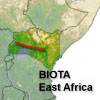Project description |
Another important goal will be the production of specific, user-oriented deliverables providing comprehensive, first hand information on the biodiversity from BIOTA East, particularly tuned towards the sustainable management of Kakamega Forest. The editorial tasks included in this work package will focus on three deliverables, a printed monograph, a series of printed field guides on characteristic parts of the biodiversity of Kakamega Forest, and a presentation of all available data generated from BIOTA East in digital form on CD/DVD.
These stand alone products are expected to offer useful tools for ongoing and future biodiversity research, as well valuable sources of information for relevant authorities and counterparts involved in deciding about the future use of natural resources in Western Kenya and beyond, thereby particularly contributing to cross-cutting themes 4 and 5 of BIOTA phase III. A common editorship should ensure that the resulting products will be streamlined thereby contributing towards communicating a joint corporate identity not only for BIOTA East, but the BIOTA framework project as a whole. Finally, these deliverables will offer the opportunity to integrate results from the entire duration of BIOTA East, not just project phase III.
The Kakamega monograph will be divided into chapters according to the different fields and approaches of research represented within BIOTA East (for details, see annex). Individual chapters will be authored by the project leaders, collaborators and counterparts of the respective subprojects. The editors will be the BIOTA East leader (J.W. Wägele), together with the WP 3 applicants (C. L. Häuser & J. Holstein).
For the field guides, the goal is to produce a small, encyclopedia-like series of well illustrated, user-friendly identification guides for a non-specialist target audience, including conservationists, local authorities, tourists, and the interested general public. These field guides will be produced as separate printed booklets wherever possible bilingually (English/Swahili), and will be made available free of charge to all counterparts and local authorities. Apart from identification aids, the characterization and illustration of individual species, each of the guides will contain short introductory chapters about the general biology and ecology of the group, other relevant biological aspects such as pollination, phytophagy, conservation needs, etc., some text on observation/collecting as well as photography and documentation techniques. Each field guide will be (co-)authored by the respective researchers and counterparts from the individual subprojects, who will be responsible for the content and retain full authors rights. WP 3 will manage all aspects of technical editorship, including layout and prepress, as well as assisting with illustrations. By providing authors with layout templates and technical guidelines it is intended to achieve a common design and corporate project identity for the entire series.
For the development and production of these field guides, close co-operation with counterpart institutions is anticipated, especially with the National Museums of Kenya in Nairobi (NMK), but also with ICIPE, WAC, KWS, and the University of Maseno. Apart from involving individual colleagues and specialists from those institutions as co-authors and for translation into Swahili, the planned field guides should serve them as templates for additional books and products to be carried out by the counterpart institutions themselves in the future. It is intended to motivate and assist with applications for financial support from the joint MacArthur Foundation and World Bank program for "local language field guides" (see: http://web.worldbank.org/WBSITE/EXTERNAL/ TOPICS/ENVIRONMENT/EXTBIODIVERSITY/0,,contentMDK:20608794~pagePK:148956~piPK:216618~theSitePK:400953,00.html), and for the dissemination and distribution of the books additional regional partners such as BOZONET, EAFRINET and others will be involved.
Two field guides will be produced by the applicants of E01-WP3 (Häuser & Holstein), one on Lepidoptera (butterflies and moths)
(Kühne 2008) and one on characteristic, eye-catching insects and other arthropods, including selected Odonata (in cooperation with V. Clausnitzer), Orthoptera (J. Holstein & M. Mungai), Coleoptera (T. Wagner), Diptera (M. Kotrba, P. Tschorsnig), Hymenoptera/Apoidea (M. Kraemer, T. Bergsdorf, F. Njeri Namu) and Araneae/Salticidae (J. Holstein, W. Wesolowska). From other BIOTA East subprojects, the following field guides are planned or already in preparation:
- amphibians and reptiles (Lötters et al.(2007)) (E08)
- bees and other pollinators (E10)
- trees and shrubs (E03)
- herbs (E03, E04)
- lichens and fungi (E04)
For the entire BIOTA framework project, it has been agreed to provide the data generated and available results from all subprojects in digital form on CD/DVD-ROM to all counterparts and partners. The data delivered by the three regional BIOTA Africa networks will be integrated by the BIOTA project leader (BIOTA South, Prof. N. Jürgens). For BIOTA East, E01-WP3 will assist with the coordination of data capture and adjustment to BIOTA standards from the individual subprojects. The joint presentation in electronic form will be accomplished in close cooperation with subprojects E02, E03, and E15, as well as with BIOTA South and West, and the BIOTA IT-coordinator G. Muche (Hamburg). In addition to input and delivery of data from BIOTA East towards the joint BIOTA presentation, WP3 will also ensure that the contributions from BIOTA East subprojects can be presented with a common corporate project identity. Towards that end, apart from coordination efforts, assistance with illustrations and imaging will be available to all subprojects from WP3.
For the completion of these tasks, it is anticipated that supplementary field visits will be necessary to obtain additional documentation for individual subprojects and organism groups, and to take photographs of missing species in the field. The main focus will be the Kakamega Forest Reserve with short visits to the other BIOTA East investigation sites (Mt. Kenya, Budongo Forest) as needed. |






 Go to the WeatherNet
Go to the WeatherNet BIOTA East Africa - Workpackage(s)
BIOTA East Africa - Workpackage(s)